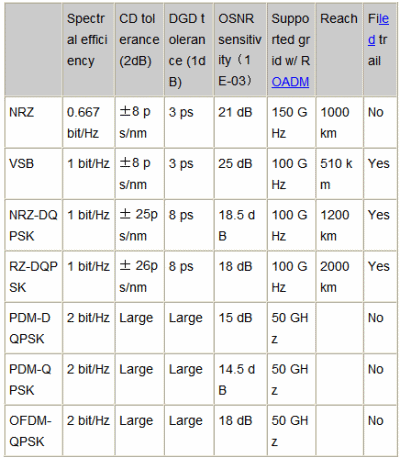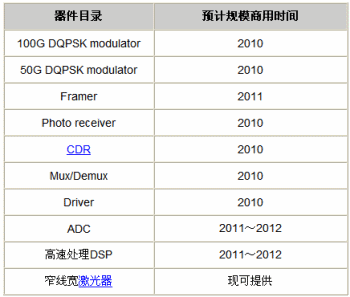New development of 100G transmission technology
In 2008, the WDM system based on the 40Gbps rate has been commercialized on a large scale, and many operators and equipment vendors have set their sights on the 100G WDM system. With the completion of 100GE router interface standardization, 100G long-distance transmission has also entered the agenda. Compared with the 40Gbps WDM system, the commercialization of 100G transmission needs to solve four key technologies: 100G line transmission technology, 100GE interface technology, 100GE package mapping technology and 100G key device technology. The following summarizes their latest progress.
100G line transmission technology
The existing 100G line transmission technology mainly has two schemes: multi-wave transmission scheme and single-wave transmission scheme.
In a 100G multi-wave transmission scheme, 100G signals are reverse multiplexed into multi-wavelength 10Gbps / 40Gbps OTU2 / OTU3 signals. This solution will not affect the existing 10G or 40G optical transmission network, and can be implemented under the existing device technology, so it is a solution that can be implemented at this stage. However, the wavelength utilization of this scheme is low, and there are also wavelength management and control of the delay difference between multiple wavelengths, so this scheme is not the final commercial scheme of 100G line transmission technology.
The 100G single-wave transmission solution can achieve "one service, one wavelength", which can simplify network management. From the perspective of device development and OPEX reduction, this solution is the direction of future development. The 100G transmission discussed in the industry is basically a 100Gbps single-wave long-distance transmission.
Due to the increase in baud rate, various physical damages to 100G single-wave transmission signals have been severe. The industry has studied new code patterns to reduce the impact of physical damage on 100G signals. Table 1 shows the comparison of related performance indicators of 100G transmission systems using different code types in the industry.
To increase the 40G rate to 100G, the optical signal-to-noise ratio OSNR needs to be increased by about 4dB. In order to reduce the optical signal-to-noise ratio OSNR requirements, the transmission of single-wave 100G signals on the existing optical network requires the use of special modulation techniques to reduce the baud rate . For example, PDM-DQPSK can reduce the signal rate of 100Gbps to 25G baud rate due to the dual modulation of polarization state and phase, thus ensuring the transmission in the wavelength region of 50GHz interval. In order to better improve the receiving sensitivity, sometimes it is necessary to adopt the technology of coherent electrical processing, that is, the electrical processing is used to solve the coherent reception of the optical wavelength.
There are currently many options for the modulation technology of 100G WDM. Regardless of the solution, the industry has realized that the 100G pattern must be normalized to the (D) QPSK pattern. This is because the quasi-constant envelope characteristic of the (D) QPSK pattern can make the cross-phase modulation (XPM) effect in DWDM transmission very small, while effectively improving the spectrum utilization rate. Research on 100G line transmission technology will focus on increasing spectrum utilization and reducing physical damage to the signal. The operator's 100G transmission network will choose a code with good performance in both aspects as a mature commercial code. From the current development situation, the industry believes that PDM- (D) QPSK will be a good choice. It can achieve 50GHz intervals and more than 1000 kilometers of electrical relay transmission. Coherent optical detection can greatly improve the dispersion tolerance And PMD tolerance. The disadvantage is that the transmitter's optical structure is complex (PolMux), the phase modulation effect tolerance is low (especially XPM), and complex DSP processing is required. There are currently fewer high-speed DAC and ASIC chips for post-processing. At present, research in this direction is still in the laboratory stage.
From the system point of view, considering that the rate of 100GHz is only 2.5 times higher than that of 40GHz, the number of wavelengths transmitted in the C-band should remain the same as the current WDM system. Therefore, the 100GHz WDM system should be based on a 50GHz interval to increase system capacity.
100GE interface technology
100GE interface technology should solve the high reliability of 100GE physical ports and support perfect monitoring and protection functions. There are three main types of 100GE physical interfaces: 10 × 10G short-distance (100m) interconnected MMF LAN interface; 4 × 25G medium- and short-distance (3km / 10km / 40km) interconnected SMF LAN interface; 10G copper wire copper cable interface.
In terms of interface architecture solutions, the 100GE interface architecture currently has three solutions: MLD & CAUI (MulTI-lane DistrubTIon & 100 Gigabit Ethernet Attachment Unit InteRFace), APL (AggregaTIon at the Physical Layer) and PBL (Physical Bundling Layer):
The MLD & CAUI solution can well implement unified interface support for 10 × 10G and 4 × 25G optical modules. However, because the CAUI interface uses bit multiplexing, it disrupts the way data is distributed and arranged on multiple channels. When it is necessary to perform independent processing for each channel, or when the data in the channel needs to be maintained in a specific order, the CAUI scheme will have certain difficulties in interface processing.
The APL scheme provides a block to multi-channel distribution scheme. For applications based on channel processing, existing technologies can be borrowed. This scheme uses slicing technology, and needs to consider the transmission efficiency caused by the size of the slice. In addition, the operation of adding frame headers and frame tails increases the complexity of device processing.
The PBL scheme provides a distribution method of blocks to multiple channels. For channel-based processing applications, existing technologies can be borrowed. The discrete PCS (Physical Coding Sub-layer) processing technology of this solution reduces the design difficulty of the chip.
VL & CTBI, APL, and PBL schemes are proposed according to different application requirements. These schemes will be discussed extensively in IEEE in recent years, and finally give the best scheme.
100GE package mapping technology
When 100GE is adapted to OTN, it can be mapped into OTU4 or multiplexed into OTU2 / 3 in reverse. According to the specific implementation form of the 100GE interface, there are multiple encapsulation mapping paths.
First, the 100GE serial signal is mapped to ODU4.
The specific rate of ODU4 / OTU4 is under discussion, there are two options of 130Gbps and 112Gbps. Since the rate of ODU4 / OTU4 has not been finalized yet, the scheme for mapping 100GE to ODU4 has not yet been finalized.
Second, the 100GE serial signal is multiplexed in reverse to ODU2e, ODU2, ODU3.
There are two schemes: ODU2e-10v inverse multiplexing and ODU2-11v or ODU3-3v inverse multiplexing. ITU-T Q11 has clearly standardized these two types of encapsulation mapping paths. The GMP (General Mapping Protocol) mapping method is technically achievable, but the standard is not yet mature.
Third, 100GE signals are reverse multiplexed to 10 × 10G or 4 × 25G.
This scheme reversely multiplexes the high-speed serial 100GE signals into 10G or 25G low-speed parallel signals. At present, ITU is discussing the problem of carrying MulTI-lane 100GE. There are mainly two solutions: multi-lane PCS layer convergence and mapping to OTN, and bit transparent independent mapping.
The above three mapping schemes are currently being discussed in ITU-T, and the standards are not yet mature. 100GE related standards will be completed in mid-2010. For single-wavelength transmission, it is an important issue to define a FEC whose gain satisfies the requirements without adding much overhead. The current focus is on 7% or 25%.
100G key device technology
The industry initially estimates that 100G key devices will begin production around 2010, and large-scale commercial use will begin in 2011/2012. The key high-speed optical devices required for 100G transmission solutions and the expected maturity time (scale commercial time) are shown in Table 2.
Among them, optical modules and high-speed DSPs have the greatest influence. Only high-speed optical modules can achieve 100Gbps modulation. DSP is crucial for coherent electrical reception. Only when a breakthrough is made in 100G high-speed digital processing technology can complex soft processing of soft-decision and coherent electrical reception be realized, thereby improving the receiving sensitivity and increasing the transmission distance of 100G.
summary
The most important feature of optical communication is that it has almost inexhaustible bandwidth resources. With the development of the information society, the demand for information services is increasing day by day. According to China Telecom's forecast, within the next five years, the bandwidth will grow at a rate of more than 50% per year. By 2010, the trunk bandwidth traffic will reach more than 50Tbps.
100Gbps WDM system is an important direction. Many manufacturers are now developing 100GHz WDM products, of which Huawei is one of the active participants. In 2008, Huawei developed a 100GE Ethernet prototype and a 100G DWDM prototype.
PDM-QPSK is currently the most mainstream modulation technology. To realize the transmission of more than 1000 kilometers in a 100G WDM system, it is also necessary to bring greater gain to OSNR in terms of FEC scheme, coherent reception, and soft decision. Coherent reception requires strong electrical processing capabilities, and powerful DSP processing capabilities are important supports for coherent reception, super FEC, and high-speed optical reception. The 100G WDM system should start commercial use around 2012, and may be in North America at first, and gradually enter large-scale applications in the future.
Table 1 Comparison of relevant performance indicators of 100G systems with different code types

Table 2 100G key device scale commercial timetable

Heat film on Agriculture applications including : greenhouse seedling breeding Heating film, agricultural vegetable greenhouses heating film,,Seedling Heat Mat,Flowerpot heat mat etc.The application of heating film in animal husbandry, such as: hatching fowl heating film,far infrared sterilization heating film,etc.we are a professional and leader Chinese exporter of heat film,Customization options (for example: SMT components, flex cable and connectors) can provide the perfect complete solution that can significantly reduce assembly time and increase productivity.Providing a variety of complex shapes design, and different power designs. Membrane in the same piece electrically heated heating circuit can be designed and holding circuit,we are looking forward to your cooperation.
Seedling Heater Tray,Electric Growing Tray for Plant,Heater Mat,Seeding Heater Mat
ShenZhen XingHongChang Electric CO., LTD. , https://www.xhc-heater.com